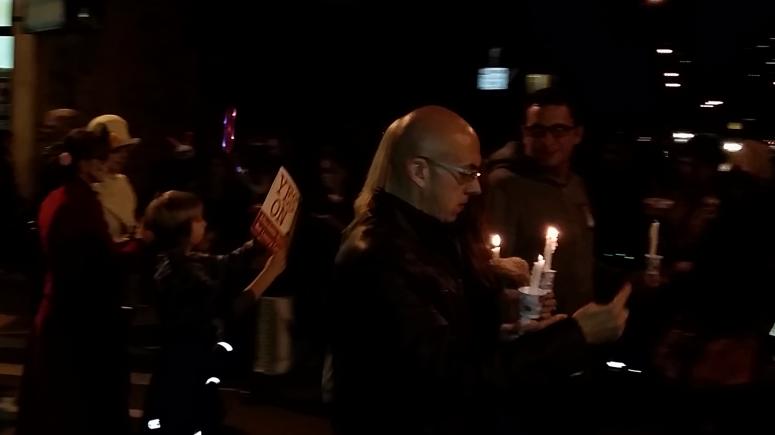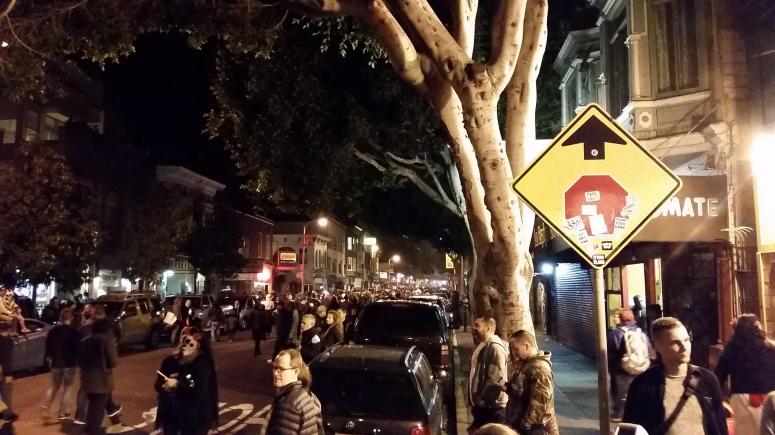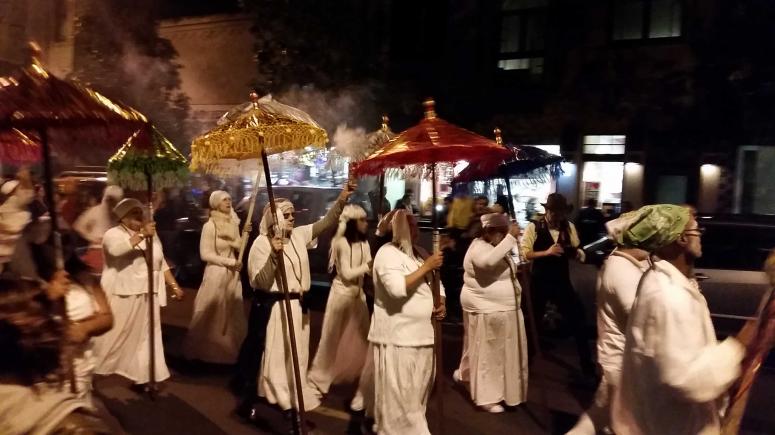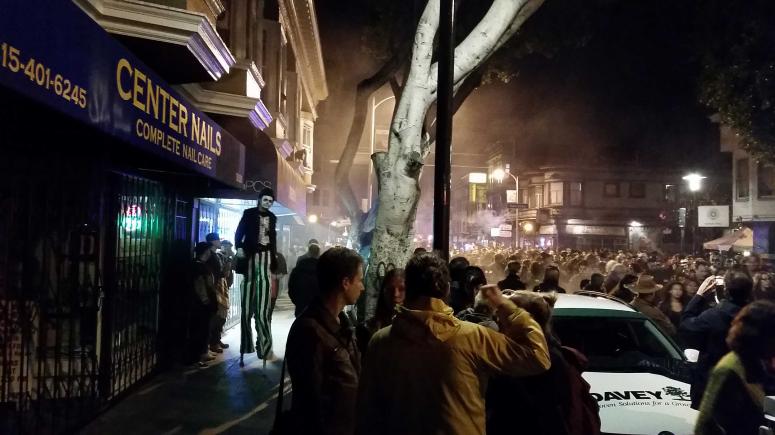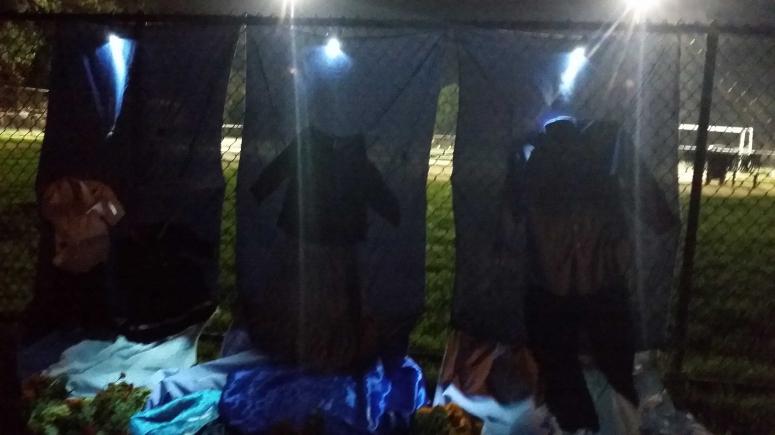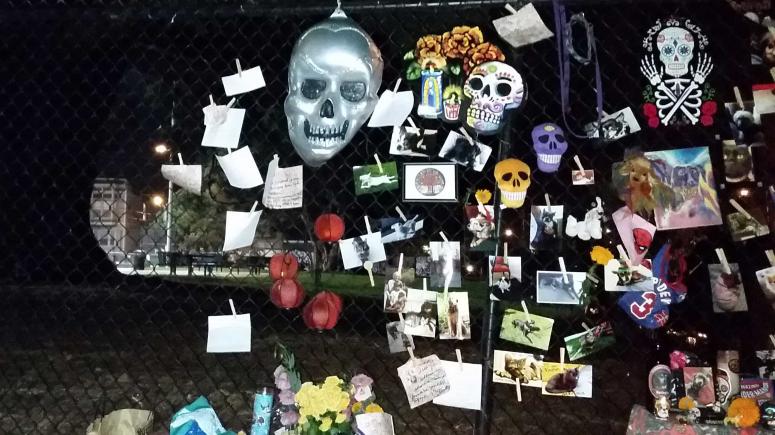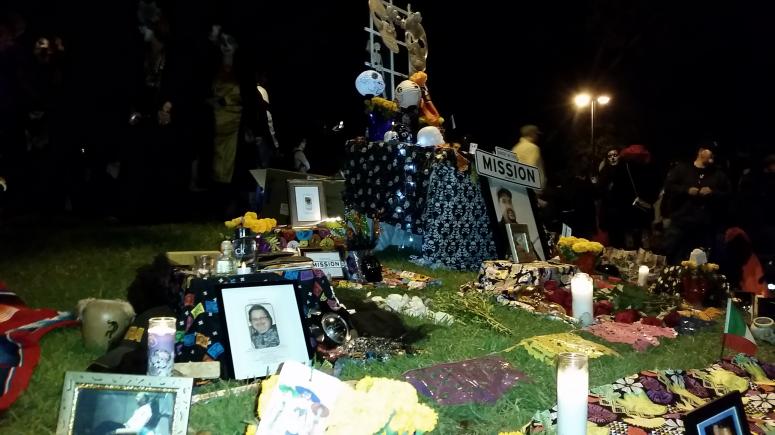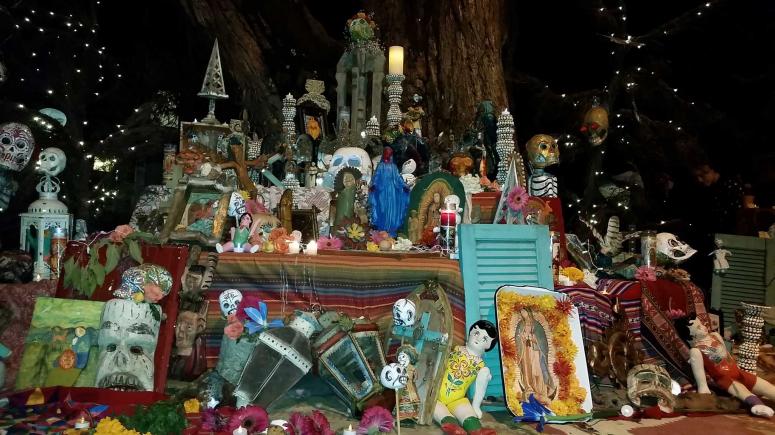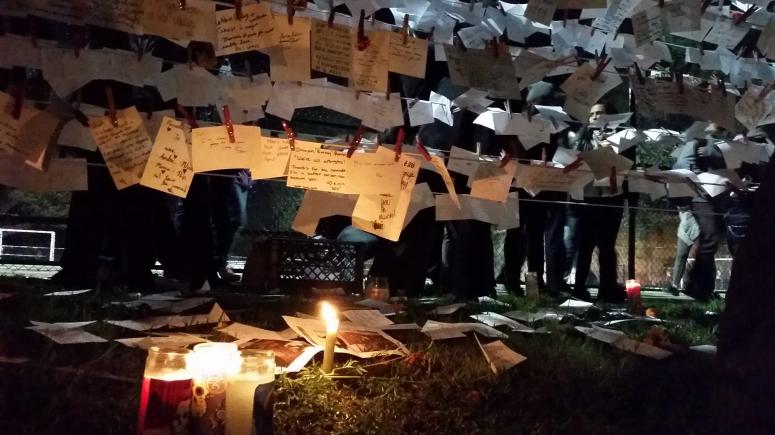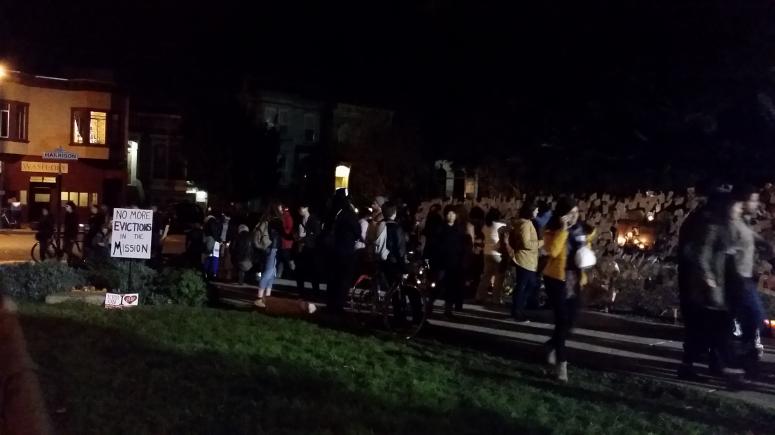
A collaborative publication of the Latin American Studies Program
Divisadero
Fall 2015
Our Dead Are Not For Sale
Dia de los Muertos is a long honored tradition throughout Mexico. It has also been a growing custom for San Francisco’s Mission district. The privately funded nature of the City’s rendition has kept the souls of the dead center-stage despite external and internal obstacles. Displacement of the Mission’s established residents has posed another concern for the integrity of the cultural festivity. Although in the face of cultural appropriation and gentrification, the Mission has kept Dia de los Muertos a unique celebration.
Scents of sage and the beats of drums converge in the air and flow down the streets of the Mission. These sensations come from a Caribbean style music group dressed in white garbs. Thousands of people are rising out into the night to pay homage to those who have passed on. The streets are alive with the dead on this brisk Monday night. In the beginning of every November, for over three decades, the Mission has had its own unique Dia de los Muertos celebration. Anyone can join the free event that combines a procession and altars which proudly display the neighborhood’s rich Latino culture. The course of the procession marched parallel with taquerias, panerias, and bookstores that have been a legacy of the Mission for decades.
This unique characteristic of the neighborhood has been changing over recent years. Long-established residents who have integrated the Mission with its Latin spirit are being replaced by newcomers with an entrepreneurial essence. Housing prices have gone up with the arrival of new residents who earn more income in comparison to traditional inhabitants of the Mission District. Vacation rental homes shared through AirBnB and the development of luxury condos are making landlords increase rent, buyout, or evict their tenants. The Mission’s Latino population has been greatly affected by the situation, which at current rates will cut half to just at 31 percent in 2025, compared to 60 percent in 2000. Those who brought Dia de los Muertos to the Mission are being displaced.
The growing concern over housing rights had a presence during el Dia de los Muertos. Posters in support of Proposition I were seen throughout the night. This proposal, which failed to pass the day after, sought to halt development in the Mission in order to create a stabilization plan. Altars included images of Mission Street signs, as though this district as it was once known was soon headed to the afterlife. The political ramifications were visible on the eve of a major election for San Francisco. Mission residents were there to mourn and heal over the passing of their loved ones, and the neighborhood as they knew it. This was a significant night for participants to meet in the streets to cope and grieve as a community.
Dia de los Muertos has served as a healing power for centuries. Mesoamericans dedicated a month long ritual to honor the dead during harvest time, hoping that the souls of the dead would secure their crop production. The tradition became integrated with the Spanish colonials who brought All Saints’ Day and All Souls’ Day to Latin America in the 15th century. Spanish elites sought to eliminate the indigenous celebration at first. Their fears of civil disorder brewing from the natives made them outlaw practices such as visiting graves at night. The indigenous practice which viewed death as a welcome necessary of life was going against the grain of Spanish colonial influences. The growing presence of Dia de los Muertos with its Mesoamerican roots intact is evidence of how Mexicans have resisted having their culture blotted out.
Centuries later the Latino population is facing another threat to its space in society. Colonial interests have been replaced by real estate agendas. Activists have been taking direct action against developers who view San Francisco, and particularly the Mission, as the hottest place in the country to invest in property. Projects like the “Mission in the Monster” proposed at Mission and 16th Street only offer 12 percent of affordable housing units. Only 41 units out of 331 would be feasible for someone on a minimum budget out of $61,000, in an area where $30,000 a year is more accurate. Real estate developers claim that building these luxurious structures will improve the quality of life in the area, but that seems to be directed at the affluent, often white, crowds who move in. These fresh faces enjoy the Mission’s unique cultural identity in comparison with their corporate lives, yet there presence is pushing away the very same people who brought authenticity to the Mission. Prices for simple services are going up as well. This is not an issue exclusive to the Mission. It is happening around the Bay Area, California, and all around the country. Only in the Mission it has accelerated to advanced stages. The issue of gentrification reaches far. Dia de los Muertos itself is spreading.
Festivities take place around the world. Pueblos in Mexico gather at cemeteries to honor their deceased loved ones. In denser urban areas it is common to see parks or plazas adorned with meticulously decorated altars. Countries such as Guatemala and Colombia also honor the dead during this time of the year in a similar fashion. Part of the rise of Dia de los Muertos has been to encourage tourism. As a result, festivities have become underrepresented by locals, who are replaced by visitors looking to dispose their income on souvenirs, food, and entertainment.
The Mission has faced its own struggle to keep Dia de los Muertos in tune with cultural tradition rather than dissolve into a commercial fair. Dedicated groups have worked tirelessly to keep the identity of San Francisco’s mixture of festivities alive in its own version. The Marigold Project and the Rescue Culture Collective have been organizing this event for the community for years. The motto which has stayed with the producers since the beginning is: “Our dead are not for sale”. This explicitly implies that Dia de le Muertos organizers do not take sponsorships from any entity. Private donations have allowed Dia de los Muertos to stay true to the lives of the loved ones who have passed on.
The director of the procession, Juan Pablo Gutierrez, from the Rescue Culture Collective, can recall plenty of monetary offers that he stoutly turned down. The offers do not come lightly either. An advertising firm in Miami presented Mr. Gutierrez with a $100,000 deal to set up booths promoting their products throughout a five year period. Mr. Gutierrez rejected them. He has also had to resist internal elements who try to take over and commercialize the holiday. For instance, individuals have tried to market local professional sports teams into floats, or divert processions into venues charging entrance fees. Yet, after thirty years Dia de los Muertos has maintained its focus on the souls of the dead.
Although through the dead, important political issues surface out of their stories. The use of art is able to assimilate issues such as displacement and violence into the traditional themes of Dia de los Muertos. One of the concerns displayed through the altars this year was how youth have been targeted by law enforcement, such as the case was with Alex Nieto, a young Latino male killed by the police before starting his shift as a security guard (his story was covered in Divisadero Fall 2014). Other recent cases such as the death of Amilcar Perez Lopez were the inspiration for these altars. Lopez’s incident has brought attention to the treatment of immigrants by law enforcement. Dia de los Muertos has incorporated these issues and continues to adapt to current ones.
The issues that are seen throughout the altars do not strictly pertain to the Mission. Broader issues are also given attention. One altar was dedicated to the lives of Syrian immigrants who died crossing the Mediterranean Sea. Another altar was dedicated to victims of cancer. Each one carries a personal story of life’s triumphs and losses. Art is the conduit where the living and dead can make political statements together.
The procession’s guest artist this year, Cecilia Sanchez Duarte, understands the healing power that her work is capable of. Based in Mazatlan, Mexico, she has organized a growing celebration in the picturesque coastal town. Unique in its own interpretation, the Festival Cultural Mazatlan includes ballet, contemporary dance, and musical performances throughout the city’s cultural institutions. Mrs. Duarte recognizes that there is a social catharsis with death that is vibrant during Dia de los Muertos. People of all different races from festivals in Mazatlan and the Mission alike have approached her to express thanks for creating artwork that helps release the emotions surrounding the loss of their loved ones. While the Mission has been faced with the displacement of its long-time residents, Mexicans have struggled with the outright disappearances of loved ones.
In September 2014, forty-three students from the state of Guerrero were kidnapped and killed. Government investigations purported that it was a case of mistaken identity where corrupt policemen handed the students over to cartels thinking the students were rivals. However, the public demanded that the dossier stay open in order to find out the truth. The horrific crime has transformed into a political statement, one which the Mexican public has relentlessly kept in the government’s eye. It is issues such as these which permeate into Dia de los Muertos’ ritual to life and death. Mrs. Duarte notices it as a tangible progression taken from the reflection of death. A community has the potential to strengthen its bond as it unites behind solving certain problems,
A woman of many talents, Mrs. Duarte has also studied sociology, which is shown through her art. She finds that solely using black and white has allowed her art to stay focused on the message. For example, her image of a skeleton deer refers to eco-cide, and her piece of a female skeleton with a French hat alludes to European intervention throughout Mexico’s history. Her most recent piece, inspired by quantum physics, deconstructs the individual feeling of isolation to show how energy is shared between persons without boundaries, where people can affect others’ lives without knowing it. Mrs. Duarte observed what she saw as a river of people in the procession in the Mission and Mazatlan as being an actualization of her latest creation. People were out on the streets connecting through a common mourning. Equally as important is how people who share concerns have a greater ability to make demands.
Many people that night could be seen demanding political changes in San Francisco. There was a clear presence of residents who were upset with the ongoing gentrification of the Mission. Different avenues were taken against the issue. Aside from Prop I signs, cards were handed out in support of Mayoral candidate and Mission resident Francisco Herrera, who decided to run in face of the drastically shifting demographics of the City. A day later he lost finishing at second place with 15.04 percent of the vote to incumbent Ed Lee’s 55.3 percent. Mayor Ed Lee himself has vowed to take action on the housing crisis, but those outcomes are rare when real estate investors such as Ron Conway are familiar faces to Lee’s administration.
The population issues in the Mission could be better solved with those with a greater stake to the neighborhood. Latinos no longer make up the majority of the neighborhood. Between 2010 and 2012 white residency increased by over 20 percent becoming the largest group, hovering near 70% total. Meanwhile, Latino population growth in this area has slowed down to just below 60%. The influx of these white residents is generally from high paying tech jobs. On the other hand it is common for the Mission’s Latino residents to take up jobs in the service sector which hardly earn as much income as a software engineer. However, the close proximity that Latinos have to the City where they work is ideal in order to curb pollution, congestion, and the tumultuousness that comes from already hectic traffic in the Bay Area. It is something that has helped them to survive in an evolving urban landscape. San Francisco’s status as a sanctuary city has proved to be especially important to the Latino population. Those who migrate to escape unsafe conditions in their native countries find solace in the Mission. The service jobs they can find here may not utilize all their skills but they offer support. Only now more than ever it has been difficult to stay near these jobs and keep them with the consequences of the housing crisis.
Market rate housing rates have crept their way into the Mission, forcing many residents to leave the area. Oftentimes they are displaced by landlords who use aggressive tactics. The Ellis Act has been manipulated to help these land speculators evict tenants. In 2013 alone, 79 percent of Ellis Act evictions were made by landlords with less than five years of ownership. Evicting tenants after such a short period of time is suspicious considering the Ellis Act was created to help landlords exit the rental business altogether. Those who are evicted or bought out are losses to the tight knit community.
The neighborhood was finding a way to cope with its changes during Dia de los Muertos. Mr Gutierrez is well aware of the multi-cultural and multi-generational healing process that is facilitated by the Latin American holiday. When he started organizing the procession over thirty years ago there were a couple of hundred people participating. That number has exponentially grown to the thousands. This year saw approximately 115 houses displaying altars to contribute to the holiday. The community is growing on the vibrancy and availability that Mr. Gutierrez has helped the festival to operate with. It is has become a large multi-cultural event recognized throughout the country.
People from other cultures are joining out of respect for the holiday without turning it into an alcohol fueled party. Before this year’s festival Mr. Gutierrez had received a substantial number of emails from the white community asking if it was fine for them to paint their faces and walk in the procession. Mr. Gutierrez encouraged them to do so, noting that incorporating the community as a whole increases the healing power of Dia de los Muertos. Those emails came out of sensitivity to the glaring issue of gentrification and displacement in the Mission. Despite the rapidly changing urban environment there is a need to include everyone. Mr. Gutierrez views survival and incorporation intertwined; the more that cultures intersect the more commonalities are noticed between one another which can then build lasting support throughout the community. A stronger community fabric is needed to push back against the tide of gentrification to save the Mission’s Latino population, one of the most affected groups in the district.
Following the tradition behind Dia de los Muertos is helping the Latino rightfully claim its place in the public space. In the past there was a growing concern that the event was becoming into a scene one would encounter at the Castro’s Halloween celebration, which was notorious for attracting inebriated crowds, and recently cancelled. Only it was worse for Dia de los Muertos because as an ethnic holiday, it was at risk of becoming culturally appropriated. Eliminating alcohol from the holiday has helped participants to stay close to the meaning of Dia de los Muertos. Keeping the event privately funded festival and adorned with inexpensive altars has helped it from deviating. The festivity has created a perspective that teaches generations old and young alike to diverge from the commercialism that infects their identity.
Others perpetrate to commoditize the holiday. Mr. Gutierrez staunchly defended “Dia de los Muertos” from being trademarked by Disney. Amnesty International took up Mr. Gutierrez’s side and sued Disney, thus forcing them to call their movie the “Book of Life”. Commercializing these cultural aspects weighs heavily into Mr. Gutierrez’s definition of cultural appropriation. Face painting, altars, and other modes of participation are safe from this label granted that they are done out of genuine respect.
There was a visible effort to honor the holiday this year. The mood of the night was mournful and yet at the same time hopeful. Participants could not disregard the looming effects of gentrification in a Latino holiday in the Mission. Community organizers and artists such as Mr. Gutierrez and Mrs. Duarte keep the public conscious of the political issues affecting neighborhoods. At the same time they are rescuing culture by practicing and participating in it with an open invitation to the City. A traditional Dia de los Muertos in the Mission will continue to thrive with this unwavering support. Yet the struggles with resisting commercialization still exist, parallel with neighborhood’s displacement. This year’s crowd assuaged fears of cultural appropriation worsening, given that a somber mood permeated throughout the procession and altars at Garfield Park. Dia de los Muertos can fend off being culturally appropriated with its dedicated group of organizers who maintain the focus on our dead, along with the artwork which works like glue bringing a diverse crowd together.
Although, the shadow of gentrification will raise these concerns once again if the Mission’s traditional population continues to be displaced by landlords, real estate developers, and city officials. Those who brought the diversity to the Mission should remain if the neighborhood is to retain the authenticity that attracts newcomers and visitors alike. Unfortunately the outcomes of San Francisco’s recent election did not pass measures to curb this issue. Yet with diversity and political statements mixing together in Dia de los Muertos, a stronger voice is given to those being displaced.

